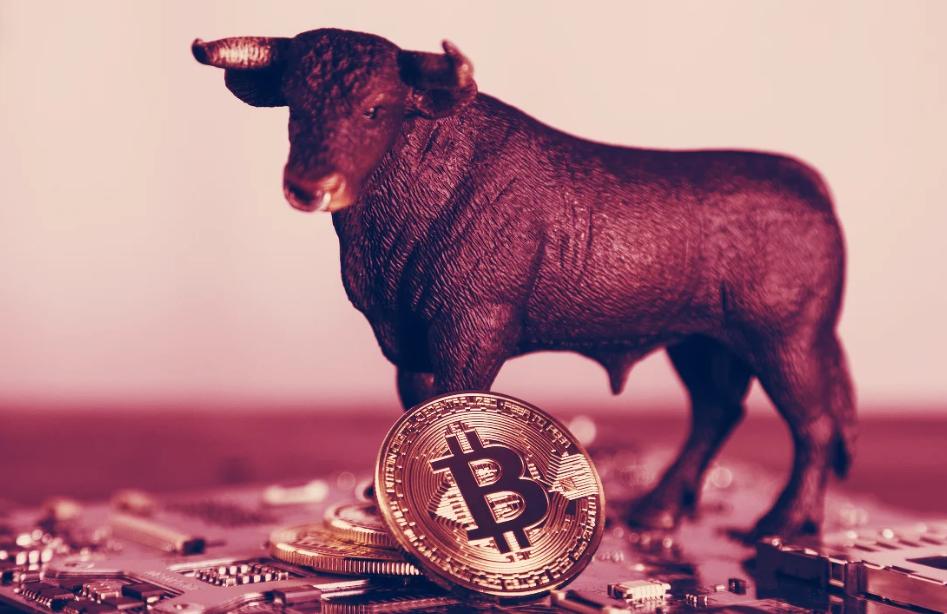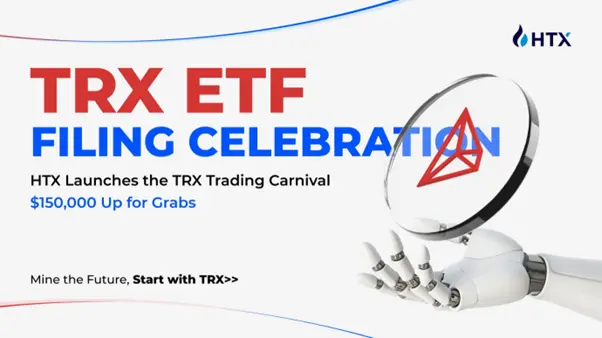Countdown to Bitcoin Spot ETF Approval: The U.S. Will Not Let Go Easily
^Produced by|OKLink Research Institute^
^Author|Hedy Bi^
One day before the news of the approval of the Bitcoin spot ETF application, SEC Chairman Gary Gensler tweeted on X warning about the risks associated with virtual assets. This statement led the market to believe that the probability of the Bitcoin spot ETF application being approved had increased, causing the Bitcoin price to break through the $47,000 high this morning.
 Source: Bloomberg
Source: Bloomberg
Not only is market sentiment soaring, but the applicants are also making ample preparations. The asset management company ARK Invest, founded by Catherine Wood, will become the first Bitcoin spot ETF applicant to receive a final response from the SEC. At the end of last year, ARK sold all of its remaining GBTC positions and used about half of the $100 million to purchase BITO, "possibly as a liquidity transition tool to maintain beta exposure to Bitcoin," and included it in ARKW (ARK Next Generation Internet ETF) or ARKB (Ark 21Shares Bitcoin ETF, the Bitcoin spot ETF that ARK is applying for). All parties in the market are poised for action; if the U.S. SEC approves the Bitcoin spot ETF, it would signify the potential end of a decade-long struggle since 2013, when institutions first applied to the SEC for a Bitcoin spot ETF but were consistently denied!
The U.S. will not easily relinquish its bargaining power from Wall Street; ETF approval will bring a cumulative effect of bargaining power
If the spot ETF lowers the threshold, public funds, private equity funds, and individual investors will be able to participate in the virtual asset market as easily as buying stocks on traditional stock exchanges, directly holding Bitcoin, thus removing the restrictions of compliant channels. In the short term, the market effect brought by the influx of funds is just one aspect; more importantly, the U.S. will enhance its bargaining power in the crypto market through the ETF, becoming a rule-maker in the industry.
As Bitcoin mining power shifts from China to the U.S., the U.S. now accounts for 40% of the global Bitcoin hash rate, ranking first in the world. This means that on the supply side, the U.S. has already gained its bargaining power.
 Image: Global Bitcoin Hash Rate
Image: Global Bitcoin Hash Rate
Source: worldpopulationreview.com
If the spot ETF is approved, it means that institutional holdings and trading data will be disclosed, providing more market transparency for regulators and market participants. With this information, regulators can better oversee market activities, reducing the risk of market manipulation and fraud. As illustrated below, we can draw an analogy: while we know that "every drop of water" can be easily traced, tracked, and verified on-chain, it is quite challenging for regulators to oversee "every drop of water." If we concentrate these drops and store them in glass containers, and impose such regulatory requirements on each "glass cup," regulators will be better able to formulate rules and manage the market.
For the U.S., if the ETF is approved, it further solidifies its position as a rule-maker and market leader in the crypto market. Regardless of whether the Bitcoin spot ETF is approved, the U.S. will not easily give up this significant advantage.
 Image: OKG Research - With ETF Compliance Channel vs. Without ETF Compliance Channel
Image: OKG Research - With ETF Compliance Channel vs. Without ETF Compliance Channel
Moreover, the expectation of the Bitcoin spot ETF approval is also very evident on the supply side: competition among miners on the supply side is intense and thriving. According to data analysis from OKLink, the hash rate has been rising at an average growth rate of 5.17% over the past three months, compared to a monthly average growth rate of 1.76% during the same period last year, indicating that competition among miners (supply side) is more intense.
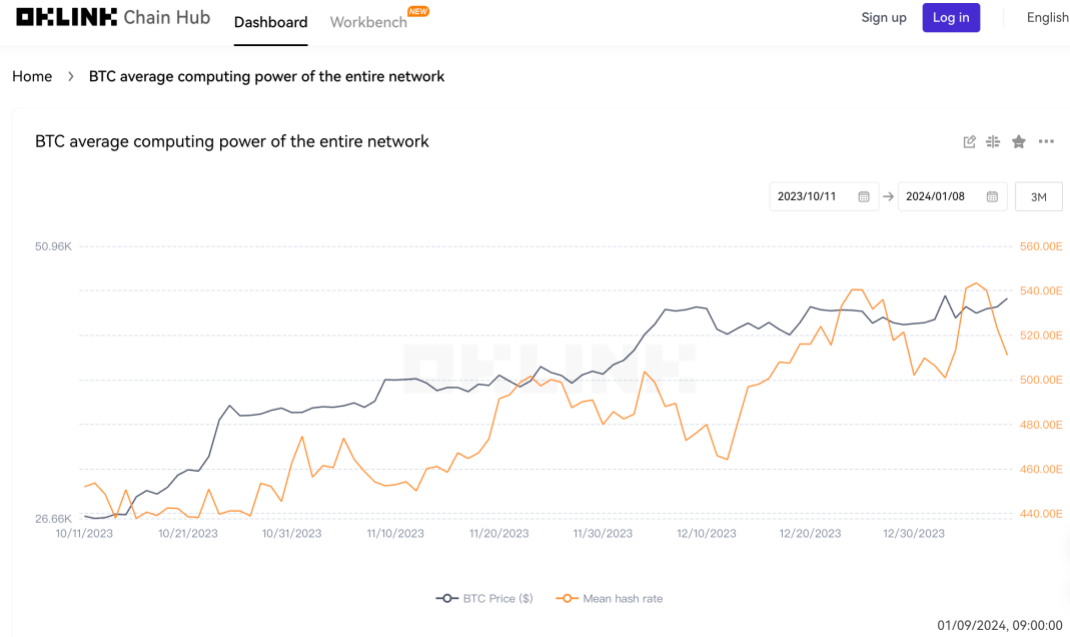
Image: Bitcoin Hash Rate
Source: OKLink
From the perspective of operating costs, OKLink data shows that the unit revenue per hash rate for miners has been continuously declining at a rate of 8% over the past three months (Figure 2), while the monthly average has instead increased, with a growth rate of about 1.55%. Despite the decline in unit revenue on the supply side, miners are still selling off to maintain operating costs.
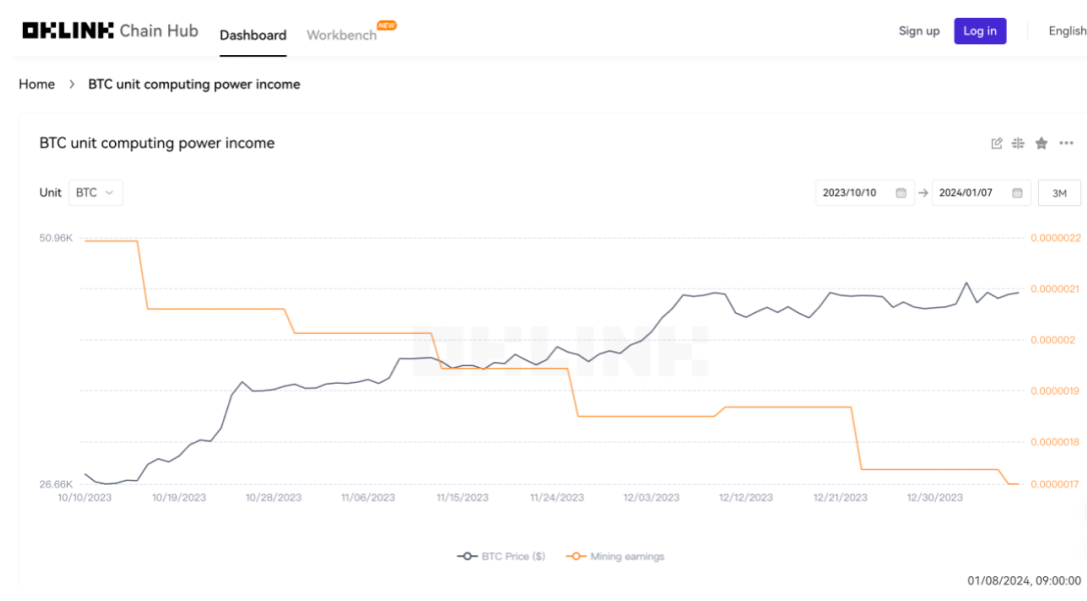
Image: Bitcoin Miners' Unit Hash Rate Income
Source: OKLink
New markets are poised for action, while existing markets are more resolute
Although the news of the ETF has long been anticipated in the market, data from OKLink shows that due to differences in time and risk preferences, new investors are willing to endure the opportunity cost of waiting for the convenience of compliant channels, giving up potential profits from early on-chain holdings. In contrast, existing market participants—long-term investors, Bitcoin supporters, and institutional investors who have long been bullish on Bitcoin—place greater emphasis on Bitcoin's long-term value.
Some early bullish institutions have already participated through other means; for example, ARK has sold all its remaining GBTC positions and injected funds into BITO (Bitcoin Strategy ETF, which invests in Bitcoin futures but not in Bitcoin itself), and Grayscale is also seeking to convert GBTC into an ETF. They may focus more on Bitcoin's fundamentals, technological developments, and market demand, and are relatively less affected by short-term market fluctuations and ETF approval news.
According to data from OKLink, it can be observed that these news events have not brought much excitement to the on-chain ecosystem. Over the past three months (from October 10 to January 7), the total number of Bitcoin (BTC) on-chain addresses has shown a steady upward trend, with an average monthly growth rate of 1.16%. Compared to the same period last year, the growth rate remains flat.
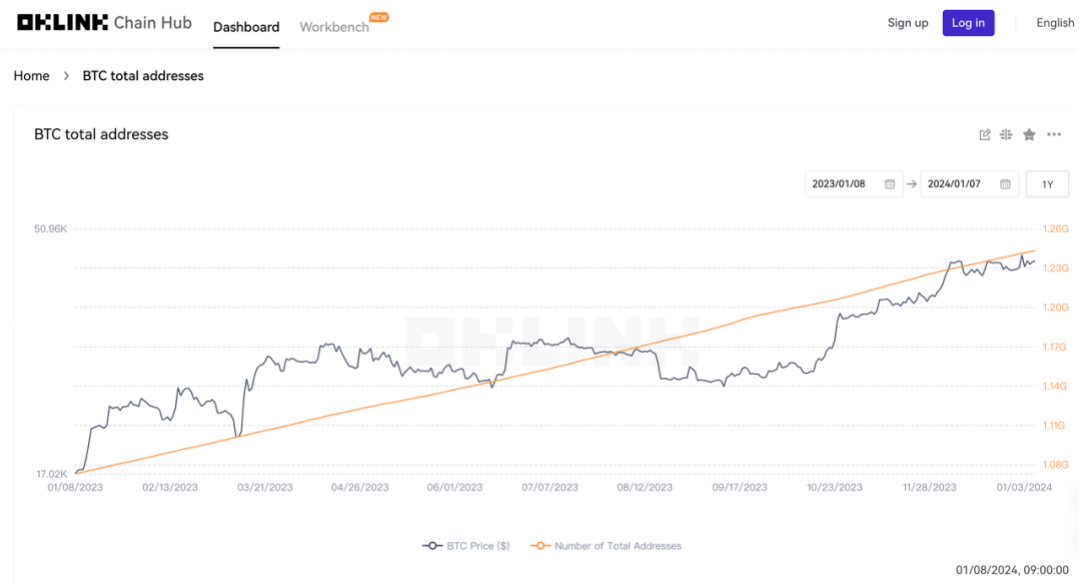
Image: Total Number of Bitcoin Ecosystem Addresses
Source: OKLink
Additionally, by observing the number of active addresses, we find that the number of active addresses did not peak when news about the Bitcoin ETF was released; rather, it was relatively high during December 2017 and March 2021.

Image: Daily Active Addresses for Bitcoin
Source: OKLink
A flourishing landscape, the era of reckless growth is no more
"Are you planning to start over?"
Even if the U.S. BTC spot ETF is not approved, the market will not return to the "era of reckless growth." According to CoinGecko, there are currently eight markets worldwide that allow the operation of spot cryptocurrency ETFs, including Canada, Germany, Switzerland, as well as tax havens like the Cayman Islands and Jersey. However, this has not sparked the same enthusiasm in the market as the anticipation for the approval of the U.S. spot ETF, which further proves the significant impact of the cumulative effect brought by the U.S. in connecting the supply side and channels.
As the ETF drama in the U.S. remains "uncertain," Hong Kong, which has garnered much attention in 2023, has already taken that step. On December 22, 2023, the SFC issued multiple circulars stating that it is "ready to accept applications for the recognition of virtual asset spot ETFs." Taking Hong Kong as an example, according to KPMG's 2023 Private Wealth Management Report, as of the end of 2022, the total value of assets under management in Hong Kong's private banking and private wealth management sector was HKD 896.5 billion. If 1% of this capital flows through Bitcoin spot ETFs, approximately $11.6 billion will flood into the market.
According to the OKLink Research Institute, several financial institutions are currently planning to issue Bitcoin spot ETFs in the first half of the year. Such competition at the level of billions will also compel the U.S. SEC not to easily reject the poised spot ETFs.
Comparing the differences between Hong Kong and the U.S. regarding Bitcoin spot ETFs, there are two points worth noting for the market:
In the circular issued on December 22, the Hong Kong SFC stated that it would support both cash and physical models, providing more options for investors; the U.S. SEC adopts a mandatory cash redemption strategy, using cash redemption to reduce the risk of market manipulation, which indirectly controls APs and squeezes their profit margins from risk-free arbitrage. If APs attempt to manipulate market prices through operations in the primary and secondary markets, it may trigger market instability. Additionally, in the case of physical redemption, market makers can receive Bitcoin in exchange for ETF shares, improving tax efficiency. Financial institutions across the Pacific also hope to achieve diverse channels; according to CBNC, Fidelity and BlackRock have sought approval for both cash and physical redemptions to cater to investors who already hold Bitcoin but seek convenience in market trading and taxation.
Currently, the U.S. has submitted eight Bitcoin ETF applications, planning to trade on one of three exchanges: Nasdaq, Cboe BZX, and NYSE Arca. Among these, Cboe BZX accounts for the largest proportion, with 5 out of 8 applications. Unlike the U.S. applicants, which are all trading platforms with experience in other financial instruments, the Hong Kong circular on December 22 only indicated the requirements and conduct that intermediaries need to meet when distributing ETFs. If the U.S. BTC spot ETF is approved and trades on one of the three trading platforms according to the application materials, having such a case reference will motivate the Hong Kong Stock Exchange (HKEX) to consider providing a trading platform for Bitcoin spot ETFs issued by Hong Kong companies.

Image: On December 22, the SFC issued multiple circulars
Source: SFC
Regardless of whether the U.S. ETF is approved tomorrow, time passes, and the "Western world"-like crypto market will never return. In 2024, the crypto market will surely be "flourishing."



